Mini split ceiling cassette vs wall mount mini split….which is the best option for you?
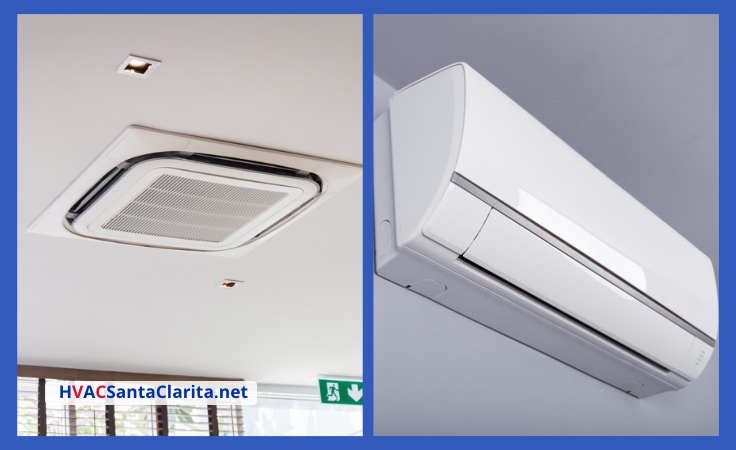
When it becomes clear that you need a ductless unit to cool your house or office, you will face the decision of choosing between a wall-mounted unit and a ceiling cassette.
The thing is, they come with different features. You must choose the best option for optimal results.
If you’re wondering which to choose, you’re in the right place. In this article, we look at the difference between the two and, most importantly, help you select which of the two suits you best.
We also offer you our HVAC services such as AC repair Santa Clarita Ca.
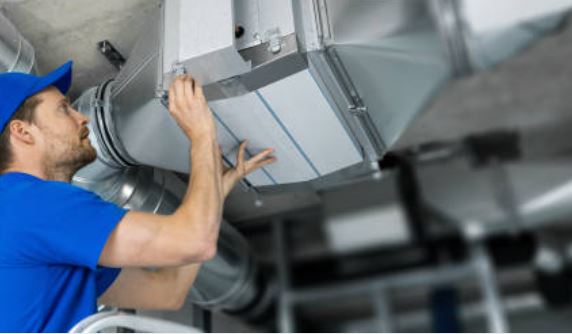
call 661-888-0248
Contact us 24/7 for HVAC services!
Shall we get started?
Let’s go.
What is a Ceiling Cassette Mini Split System?
Ceiling cassette units are a type of ductless mini-split system installed above the ceiling.
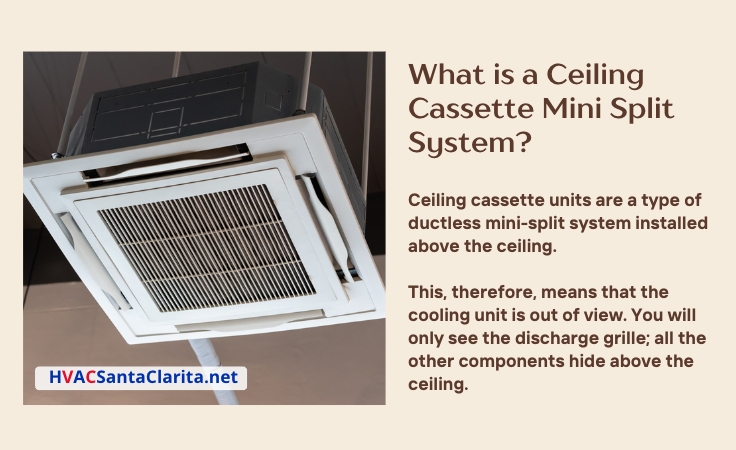
This, therefore, means that the cooling unit is out of view. You will only see the discharge grille; all the other components hide above the ceiling.
Ceiling cassettes are a great option, as they can be installed in every room and blend in well.
Ceiling cassette mini splits have air vents on their side. These are what distribute the conditioned air to the intended space. The indoor system operates in conjunction with an outdoor unit, which is similar to those found in conventional mini-split systems.
Click here to contact us for Santa Clarita furnace repair.
What is a Wall Mount Unit?
Wall-mounted units are installed on a wall, usually in a higher wall space, closer to the ceiling than the floor.
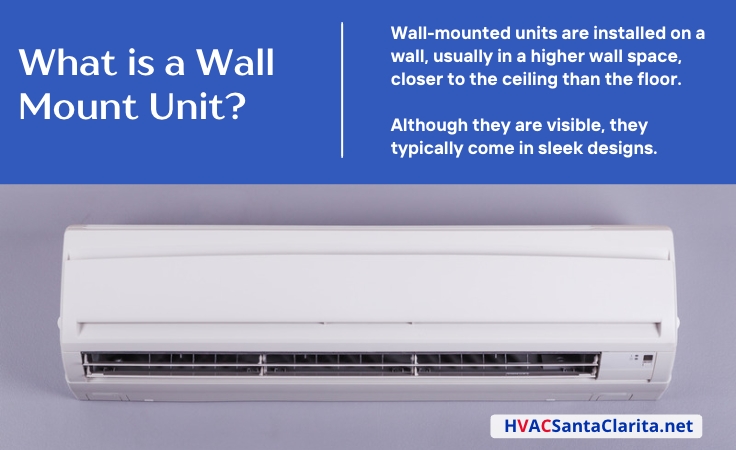
Although they are visible, they typically come in sleek designs.
Additionally, depending on the size and model you purchase, you can cool multiple rooms simultaneously. You can also go for intelligent models that are compatible with mobile devices and Wi-Fi.
Ceiling Cassette vs Wall Mount Mini Split: Noise Levels

A ceiling cassette unit will generally be quieter than a wall unit. For starters, wall units are closer to you; you will hear them working. These may make them a nice option for ductless mini splits for sunrooms.
However, the noise level difference comes in due to the fan design of the two. Ceiling cassette models have large fan designs. These designs can push large volumes of air without much rapid movement.
On the other hand, the small fan design prominent in wall-mounted units tends to make them louder. The fan will have to move more rapidly to push the needed amount of air.
Ceiling Cassette vs Wall Mount Units: Space Requirement
Mini split ceiling cassettes are designed for space saving. They only occupy space in the ceiling; you have space there.
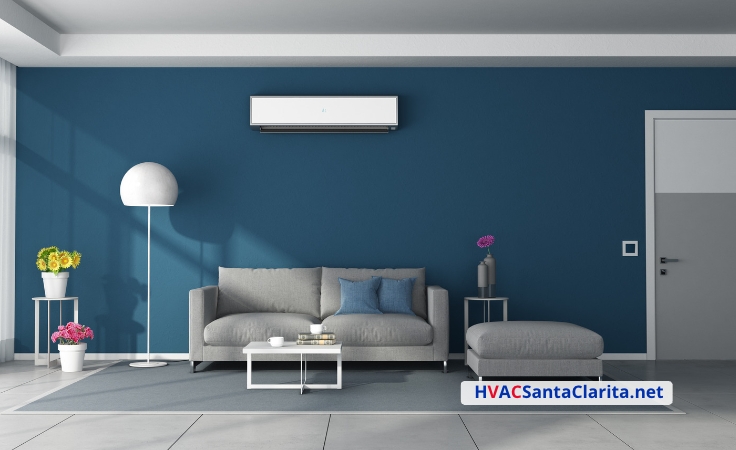
Due to their space-saving feature, they are popular in commercial spaces that lack sufficient space for wall-mounted and floor-mounted units.
The discreet design of ceiling-mounted units makes them ideal for offices, living rooms, and boardrooms.
Wall Mounts vs Ceiling Cassette Air Conditioners: Aesthetics
Are you big on aesthetics? If yes, then you are a ceiling cassette type. They are hidden in the ceiling and would not interfere with your house’s theme and aesthetics.
It does not matter, though; what your house looks like may still affect you mentally and physically, whether you care or not.
If you already have too much clutter lingering around, then a wall-mounted air conditioning system may not be the best idea; it will just add to the clutter. And depending on the mini split wall unit you choose, it may even be an eyesore.
Ceiling Cassette Unit vs Wall Mounted Units Installation
Before purchasing a mini-split system, you must ensure enough space to install it.
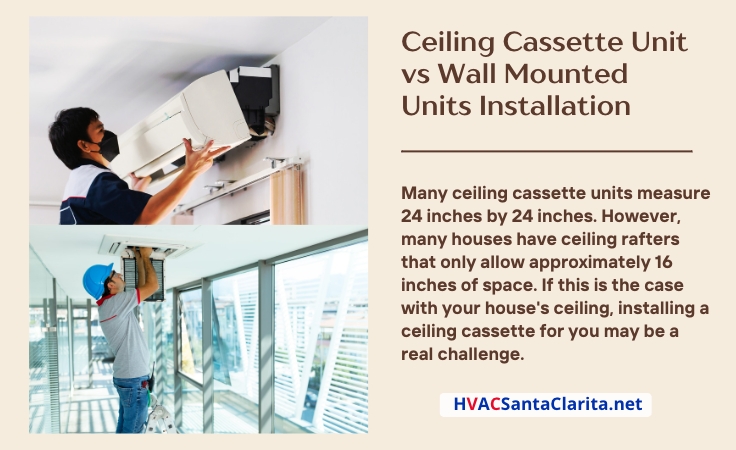
What happens if you purchase a ceiling cassette unit and later realize it does not fit in your ceiling? Yes, they are great space savers in the living space, but they need space to fit well in the ceiling.
Many ceiling cassette units measure 24 inches by 24 inches. However, many houses have ceiling rafters that only allow approximately 16 inches of space. If this is the case with your house’s ceiling, installing a ceiling cassette for you may be a real challenge.
You will also have to consider the weight of these air conditioning systems on the ceiling. Excessive weight on the ceiling may cause damage. To save weight from the ceiling, there needs to be space for rods and cables above the ceiling(1).
Simply put, have your HVAC technician inspect the space and verify whether it is sufficient to install a ceiling cassette unit.
Note: ceiling cassettes are better installed in the middle of the ceiling. This way, the vents can distribute conditioned air throughout the room. You can always go for a space beside the center if you have no other option. Just ensure nothing obstructs the vents in any way.
On the other hand, installing wall-mount units is relatively straightforward. The spacing is not always an issue; it is easy to pinpoint and find free wall space in the room.
Wall Mounted Unit vs Ceiling Cassette: Installation Costs
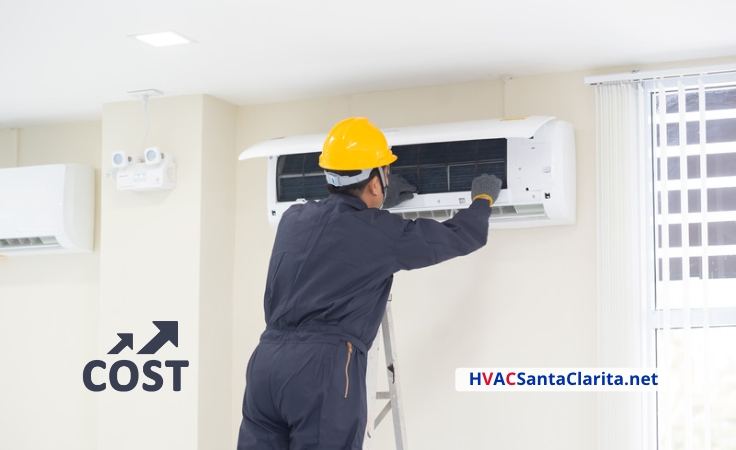
Generally, ceiling cassette units are costlier than wall-mounted units. Just buying the system will cost you anywhere from $ 1,000 to $ 10,000. It is not the ideal option for those seeking relatively affordable cooling solutions.
On the other hand, wall-mounted units are an affordable option. They cost anywhere from $500 to $ 5,000, depending on the model, size, and brand. If you are looking to get one of the best HVAC systems but still on a budget, you are safer going with a wall mount unit.
If you believe in your DIY skills, follow this procedure on how to install a ductless mini split.
Wall Mount Mini Split vs Ceiling Cassette Mini Split: Cost of Operation
Wall-mount units are more energy-efficient than ceiling cassette units and traditional HVAC systems.
Additionally, inverter units and innovative models make wall-mounted ductless units even more energy-efficient.
Ceiling cassettes have excellent cooling power, allowing them to cool a large space with minimal power consumption. However, when it comes to power consumption, they are not as great as wall-mounted units. This concept of power consumption becomes clear in the comparison between ductless mini splits and central air.
These modern appliances were energy-saving, consuming less electricity than traditional HVAC systems. Inverter units and smart models optimize the use of the air conditioner, leading to cost-efficient energy consumption without compromising cooling efficiency.
With either system, you need to learn how to optimize it for lower energy consumption.
Wall Units vs Ceiling Cassettes: Maintenance
For starters, maintaining, cleaning and servicing a ceiling cassette will always be costlier than doing the same for a wall-mounted mini split.
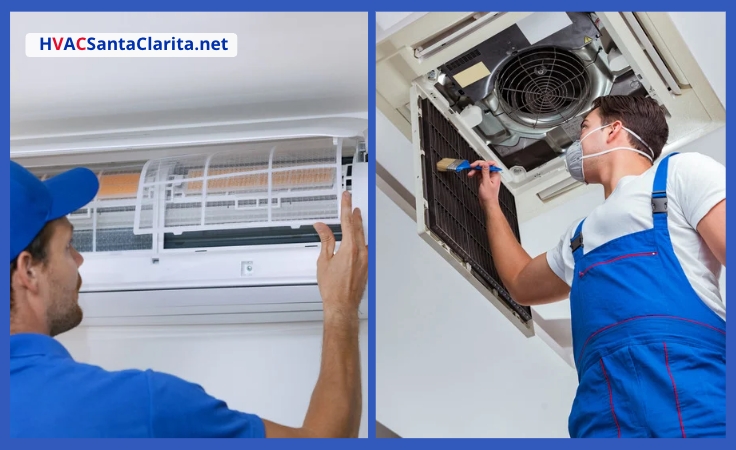
Also, for ceiling cassettes, you want to avoid DIY maintenance. Due to their location, it’s safe to leave such things to professionals.
On the other hand, maintaining wall-mounted units is almost straightforward. Some DIY enthusiasts manage to perform their own maintenance practices. For instance, you can easily remove and clean the air filters yourself.
Search for “heating service near me” to connect with HVAC technicians near you for professional servicing.
Pros of Ceiling Cassette Systems
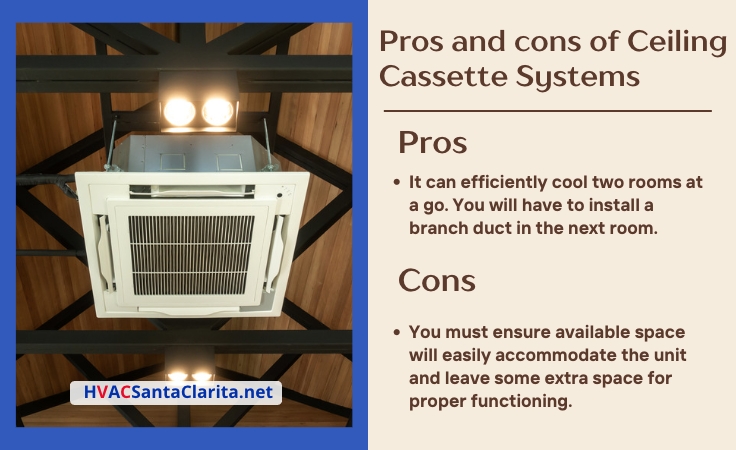
- Thanks to their large fan designs, they are better at distributing conditioned air throughout the room. This is even easier if the HVAC system is centrally positioned in the ceiling.
- It can efficiently cool two rooms simultaneously. You will have to install a branch duct in the next room.
- With ceiling cassettes, you can maximize the wall and floor spaces.
Cons of ceiling Cassette Systems
- It is costly and time-consuming to install and maintain them.
- You must ensure that the available space will easily accommodate the unit and leave some extra space for proper functioning.
Pros of Wall-Mounted Indoor Unit
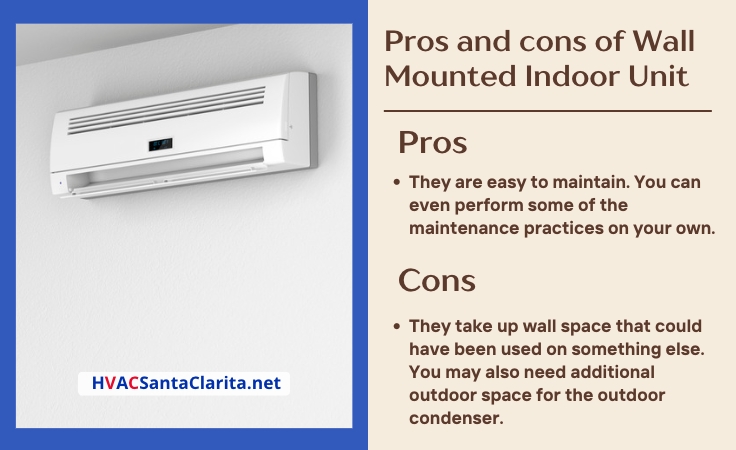
- They are budget-friendly as their installation process is pretty straightforward. They are also cheaper to buy. If you want to save money, this is the unit for you.
- They are easy to maintain. You can even perform some of the maintenance practices on your own.
Cons of Wall-Mounted HVAC Systems
- They take up wall space that could have been used for something else. You may also need additional outdoor space for the outdoor condenser.
Mini Split Ceiling Cassette vs. Wall Mount Frequently Asked Questions
Can mini-splits be mounted on the ceiling?
Yes, there are mini-split systems explicitly designed for ceiling installation. The entire indoor unit is above the ceiling. A tiny grille part, almost an inch long, will be visible below the ceiling.
Why are mini-splits mounted high on the wall?
If a wall-mounted mini split is low, it will not distribute conditioned air effectively. They sit at least six feet above the floor.
Also, installing it too low can be disruptive. Install it higher for reduced noise.
You also want to avoid sloped walls as they will inhibit the proper functioning of a system.
How big is the ceiling cassette mini split?
They typically measure 24 by 24(2). However, slight variations may depend on the brand and model you choose.
Do mini split air conditioners have outdoor units?
Yes, but the ceiling cassette type and the wall mount have outdoor units. The difference comes in the indoor units.
Final Thoughts
There is no doubt that ceiling cassettes and wall-mount units are both effective at what they do. However, neither of them can suit you perfectly. You have to analyze their features and pros and cons to find your best match.
If you’re looking for a more affordable option, a wall-mounted unit is a better choice. However, if you’re looking to save money, consider the fan vs. air conditioner comparison.
Still stuck after our ceiling cassette vs. wall mount mini split air conditioners? Feel free to message or call us here at HVAC Santa Clarita; we will gladly analyze your cooling needs and help you make the best decision for your home.
Sources
https://www.energy.gov/energysaver/ductless-mini-split-air-conditioners
https://www.forbes.com/home-improvement/hvac/best-ductless-mini-split-ac/
